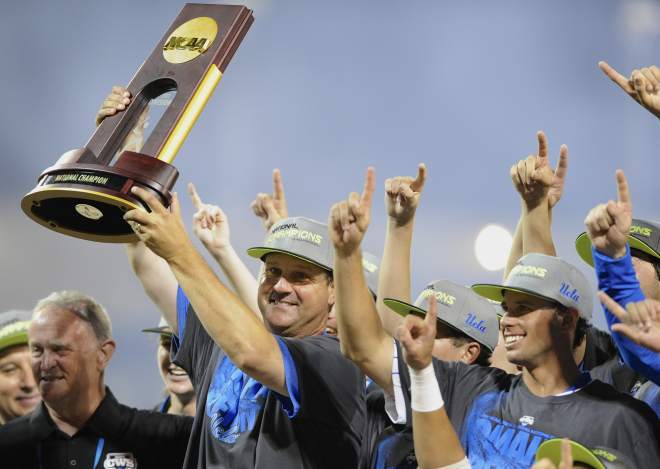
John Savage has been at the helm of the UCLA baseball program since 2005, guiding the Bruins to the NCAA postseason in seven of the last eight seasons. This past season, he surpassed the 300-win mark at UCLA and the 400-win mark in his coaching career. Before UCLA, Savage restarted the baseball program at UC-Irvine, and led the Anteaters to an NCAA Regional in just his third year. He's also one of just six active head coaches to coach a no. 1 overall MLB draft pick, a Golden Spikes Award winner, and lead his team to Omaha.
A former assistant at the University of Nevada and the University of Southern California, Savage is a graduate of Santa Clara University, where he pitched for three seasons before signing with the Cincinnati Reds after being drafted in the 16th Round. Savage was a 6 th-rounder out of High School at Reno (NV), where he began his coaching career. He and wife Lisa have four children: Julia, Jack, Ryan and Gabrielle.
Inside Pitch recently had the chance to catch up with Coach Savage about some unique opportunities that coaching has provided him and some of the philosophies he implements at UCLA:
Inside Pitch: You had the unique opportunity to begin your collegiate head coaching career by restarting the baseball program at UC-Irvine. What was that like?
John Savage: It was the opportunity of a lifetime. It kind of felt like the Diamondbacks or the Devil Rays when they started up, where we got to design the ballpark, the uniforms, the mindset of a program and coaching staff. They gave us a whole year to put the program together and it was really a great situation; we had a whole year to recruit. We got in Division I right away, won over 30 games and had the opportunity to go to a Regional right out of the gate, which is very rare.
It's a great area for players. I don't think I would've gone to any other program out of USC in 2000 other than an upstart program in Southern California. Those memories will carry us for a long time.
IP: Our most recent issue featured a “Drills” section outlining what many top college programs do on a daily basis. What are some of the drills that you implement at UCLA?
JS: Dry runs are a big deal right now. [We also emphasize] the mental game, in terms of breathing, and going through situations that maybe didn’t go the way you wanted the day before. The figure eight drill, staying on top of the baseball; the leg lift – the front foot behind the back foot; the balance drill – getting the ball and going downhill; the wall drill (with the wall behind you) – trying to get good alignment and not hyperextend; you got the chair drill with the back foot on the chair and really try to get out front. We have all kinds of drills that we use on a daily basis.
IP: The new BBCOR bats have emphasized small ball tactics such as base running and moving runners over. How are you able to get your pitchers to attack the running game without losing focus on the hitter?
JS: You gotta practice it. You talk about holding the ball. You have to have good legs. You have to be 1.3 or less or else you’ll get run into the ground. You talk about quick feet, a short arm, and the tag zone – those are the three elements of our picks. Changing your timing with the ball is also important; you can go early or hold the ball. That’s very important. We work very hard on picks to second – inside move, no-look pick, couple looks pick, the verbal
pick. On the west coast, you really have to be connected on the mound in terms of the running game or else you’ll give up 90 feet rather easily.
IP: Speaking of baseball on the west coast, what are some things that make it so unique?
JS: The parity, that’s what comes to mind. Santa Barbara, Irvine, Fullerton, Long Beach, USC, and Northridge – you gotta be ready to play on a Tuesday, on a weekend in non-conference. There are a lot of good players and a lot of good coaches. The coaches know what we know; it’s not like one coaching staff is really better than the other, I think there are a lot of complete coaching staffs.
The game will humble you; it will teach you a lot of things throughout the seasons. We have to be able to clean things up – PFP, pitch out of problems, hold runners, left on left, the changeup – there’s all kinds of things that you
learn every day that will help clean your game up.
IP: With so many advancements in technology, how do you implement video analysis at your program?
JS: We use it a ton, we’re a big video program at UCLA. I’ve watched video after every game to go through pitch count sequences and look where pitches are where they got hit, what pitches were made and what mistakes were made. At the same time, you get a good feel for their hitter or pitcher. There’s also teaching moments on days we don’t play. We really break it down with our players and go through some things in terms of their swing path (high elbow, lean, balance, eyes) and with pitching (balance points, separation, direction, finish), all kinds of things. We really try to focus on one thing. We have meetings for about 15 minutes where we focus on one thing. We don’t talk about three hotspots in one meeting because it can work the other way against you. IP